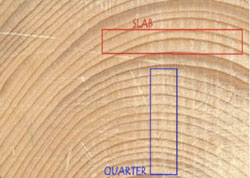Small Home Gazette, Winter 2012
Why Older Is Better
This article appeared in Style 1900 magazine, Volume 8, Number 1, May 1995. It is reprinted with permission.
 As a professional restorer of Arts & Crafts period furniture, I have been asked many questions regarding restoration techniques and conservation of original period pieces. However, the one question that is not usually asked is why older is better. I believe that this question should be addressed before any investment is made. Older is considered better by more experienced buyers because of the limited availability of good representative pieces, the value of which increases with age. For any prospective investor, it is important to understand why this is so. Older is better beginning with the wood itself.
As a professional restorer of Arts & Crafts period furniture, I have been asked many questions regarding restoration techniques and conservation of original period pieces. However, the one question that is not usually asked is why older is better. I believe that this question should be addressed before any investment is made. Older is considered better by more experienced buyers because of the limited availability of good representative pieces, the value of which increases with age. For any prospective investor, it is important to understand why this is so. Older is better beginning with the wood itself.
The reason for this is that woods that were used at the time are very difficult to come by today. Trees harvested then were from old-growth virgin forests 200 years or older. Old growth lumber is better because the trees have been growing for a longer period of time, thus yielding logs of greater diameter. These logs, when processed into lumber, produce much wider, more heavily figured (flaked) boards.

Quarter-sawn lumber is defined as boards cut from the log so the grain is perpendicular to the face of the board. This lumber is more expensive than traditionally-or slab-sawn lumber because more of the log is wasted, and it takes longer to quarter saw a log. Furniture made with quarter-sawn lumber typically costs more. (Image courtesy of Bob Yapp, www.bobyapp.com.)
It is difficult and expensive today to buy quality quartersawn white oak lumber and veneer that can even be compared to the original lumber that was used on period Craftsman furniture. Ninety to 100 years ago trees with 30-inch diameters were already dwindling due to increased furniture production, but were still far more common than they are today. Only one in about every dozen logs produced today is slow-growth of 30 inches plus in diameter. Thirty-inch-plus logs yield wider boards with superior flake. This is to say the natural patterns in the wood are more desirable. The 8- to 12-inch diameter trees which are more likely processed for lumber today yield less quantity and quality.

You can notice on original Craftsman furniture that the wider boards usually have flake that is bold and runs the entire length and width of the board. Slow-growth boards can be recognized by the tightly spaced grain lines, which run the length of the boards. Slow growth boards on period Craftsman furniture reveal these tightly spaced grains, representing each year’s growth. These patterns naturally translate darker because the space between the grain lines is minimal. Grain lines always appear darker, and when tightly spaced as in slow-growth lumber the board will appear darker when finished, lending the own simple beauty of the wood to the furniture.
Another aspect of slow-growth quartersawn oak is that it is softer than fast-growth lumber because of the absence of summerwood (the amount of growth the tree experiences during the growing season). This is probably one reason Charles Rohlfs chose to use slow-growth lumber. It was softer and hence easier for carving his elaborate designs. Roycroft, on the other hand, chose primarily fast-growth white oak which is much harder and more dimensionally stable.
Having worked on early, middle and late period furniture, I am familiar both with construction techniques and the choice of finely figured woods. The combination of quality wood, durability of design, and sound Craftsman construction could only result in a quality product. This is better when you consider buying original furniture because quality wood means nicely flaked patterns, which lends to the aesthetic beauty. (Durability of the design, such as thicker boards, solid posts and chamfered backs, means that the furniture will last longer and have less chance of becoming structurally unsound.)
 It is my opinion that the early Craftsman furniture was by far the best of the three periods because of the limited quantities produced and also because they were made from a woodworker’s standpoint, whereby design and execution were first and foremost. From a construction perspective, the boards were milled very thick and very wide. Thicknesses of 11/2 inches and widths of 9 inches were fairly common. Drawers had solid chamfered bottoms rather than plywood, and the sides and back boards also were much thicker, thus making them sturdier than the later furniture.
It is my opinion that the early Craftsman furniture was by far the best of the three periods because of the limited quantities produced and also because they were made from a woodworker’s standpoint, whereby design and execution were first and foremost. From a construction perspective, the boards were milled very thick and very wide. Thicknesses of 11/2 inches and widths of 9 inches were fairly common. Drawers had solid chamfered bottoms rather than plywood, and the sides and back boards also were much thicker, thus making them sturdier than the later furniture.
The backs of case pieces had splined “V”-groove boards. This required more material and skill. Each board had to be carefully chosen, milled to thickness and dimensioned. A groove to accept the spline needed to be cut. A spline had to be made and fitted and a 45-degree chamfer cut on the edge. Then it had to be assembled and fastened to the case. Three-inch posts were usually solid in the early furniture rather than the pieced and veneered posts found in later designs. These features found in early furniture added to the massiveness of the design as well as its durability of construction.
This is not to say the middle and late period furniture were not well constructed. In fact most were. The later periods changed the heavy, almost crude appearance of the earlier furniture to a more refined and lighter appearing design while still keeping the basic look of Mission furniture. The furniture of the later period gives one a sense of evolution when it is compared to the early designs.
As designs evolved, so did construction techniques. More use of veneers was incorporated in their construction. Pieced and veneered posts came into play, and plywood as well as maple and poplar were used for interior secondary parts. Veneer widths of over 10 inches and thicknesses of 1/16 to 1/8 inch were common. These construction changes were probably due in part to declining wood sources and competition from other Arts & Crafts manufacturers, as well as by the standard design furniture companies. A great deal of oak furniture was being produced in many styles by different companies throughout the United States during this period.
There is nothing like an original, although some contemporary reproductions are well done. From the companies I have researched, I have found the better quality pieces are usually found in the smaller shops that make custom pieces based on original Arts & Crafts design. These smaller shops, because of their concentrated efforts, produce in smaller or limited quantities. They usually can be more selective in the quality of the wood, and especially in the finishing.
As always, the first investment, the best investment you should make before any other, should be in education. Find out everything you need to know before choosing a piece. If the material, finish and construction of originals are a determining factor, pieces of Craftsman furniture, even generic pieces if well done, will always maintain and increase their value through the years. The reproductions being made today, while perhaps respectable copies, probably are unlikely to show the same return as originals from the Arts & Crafts period. Your best investment will always be with period furnishings.
Dennis Bertucci has been professionally restoring antique furniture since 1979 and focusing exclusively on restoring Arts & Crafts period furniture since 1986. His workshop is located in southern Utah, where he also designs and builds his own line of Mission-style and rustic furnishings and accessories. He has conducted hands-on finishing workshops and lectures on period restoration techniques at the annual Grove Park Inn Arts & Crafts Conference in Asheville, NC. He also wrote a restoration column for Style 1900 magazine. You can find information about his work at www.dennisbertuccifurniture.com.











